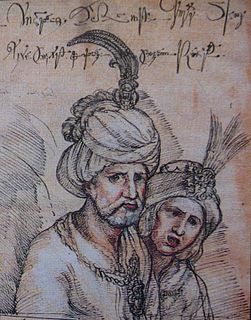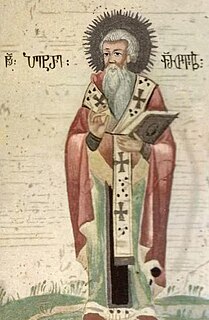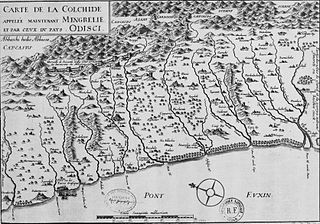
Mamuka Tavakalashvili or Tavakarashvili (Georgian :მამუკა თავაქალაშვილი) was a Georgian poet, painter and famous calligrapher of the 17th century at the court of the King of Imereti.

Georgian is a Kartvelian language spoken by Georgians. It is the official language of Georgia. Georgian is written in its own writing system, the Georgian script. Georgian is the literary language for all regional subgroups of Georgians, including those who speak other Kartvelian languages: Svans, Mingrelians and the Laz.

The Georgians or Kartvelians are a nation and indigenous Caucasian ethnic group native to Georgia. Large Georgian communities are also present throughout Russia, Turkey, Greece, Iran, Ukraine, United States, and throughout the European Union.

A poet is a person who creates poetry. Poets may describe themselves as such or be described as such by others. A poet may simply be a writer of poetry, or may perform their art to an audience.
He was captured in Principality of Samegrelo in 1634 during the Georgian feudal fights when kings Teimuraz I of Kakheti and George III of Imereti waged war against King Rostom of Kartli and the Dadiani princes of Samegrelo. After this Mamuka worked as calligrapher at the court of Prince Levan II Dadiani.

Teimuraz I (1589–1661), of the Bagrationi Dynasty, was a Georgian monarch who ruled, with intermissions, as King of Kakheti from 1605 to 1648 and also of Kartli from 1625 to 1633. The eldest son of David I and Ketevan, Teimuraz spent most of his childhood at the court of Shah of Iran, where he came to be known as Tahmuras Khan. He was made king of Kakheti following a revolt against his reigning uncle, Constantine I, in 1605. From 1614 on, he waged a five-decade long struggle against the Safavid Iranian domination of Georgia in the course of which he lost several members of his family and ended up his life as the shah's prisoner at Astarabad at the age of 74.

George III, of the Bagrationi Dynasty, was a king of Imereti from 1605 to 1639.

Rostom or Rustam Khan was a Georgian royal, from the House of Bagrationi, who functioned as a Safavid-appointed vali /king of Kartli, eastern Georgia, from 1633 until his death.
In 1646 he copied The Knight in the Panther's Skin where he created 39 miniatures.

The Knight in the Panther's Skin is a Georgian medieval epic poem, written in the 12th century by Georgia's national poet Shota Rustaveli. A definitive work of the Georgian Golden Age, the poem consists of over 1600 Rustavelian Quatrains and is considered to be a "masterpiece of the Georgian literature". Until the early 20th century, a copy of this poem was part of the dowry of any bride.
In 1647 Tavakalashvili also copied the Georgian translation of Shahnameh.

The Shahnameh is a long epic poem written by the Persian poet Ferdowsi between c. 977 and 1010 CE and is the national epic of Greater Iran. Consisting of some 50,000 "distichs" or couplets, the Shahnameh is the world's longest epic poem written by a single poet. It tells mainly the mythical and to some extent the historical past of the Persian Empire from the creation of the world until the Arab conquest of Iran in the 7th century. Modern Iran, Azerbaijan, Afghanistan and the greater region influenced by Persian culture celebrate this national epic.






